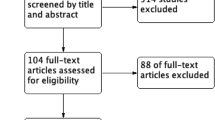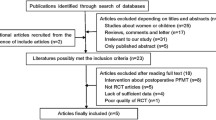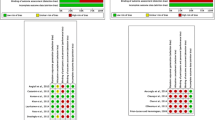Abstract
Male Stress Urinary Incontinence is a complication post robotic radical prostatectomy. This is a major problem that needs to be solved, since it has great impact on quality of life affecting the patient’s physical activity and social well-being. A systematic review relating to literature on impact of preoperative PFE on continence outcomes for patients undergoing prostatectomy was conducted. The search strategy aimed to identify all references related to pelvic floor exercises and post-prostatectomy. Search terms used were as follows: (Pelvic floor exercises) AND (incontinence) AND (prostatectomy). The following databases were screened from 2000 to September 2017: CINAHL, MEDLINE (NHS Evidence), Cochrane, AMed, EMBASE, PsychINFO, SCOPUS, Web of Science. In addition, searches using Medical Subject Headings (MeSH) and keywords were conducted using Cochrane databases. Two UK-based experts in prostate cancer and robotic surgery were consulted to identify any additional studies. In the 6 months following surgery, the continence rates, as defined by the use of one pad or less per day, were 94% (44 of 47) and 96% (48 of 50) in the PFE and biofeedback groups and control groups (PFE alone), respectively (P = 0.596) (Bales et al. in Urology 56: 627–630, 2000). This demonstrates preoperative PFE may improve early continence after RP. Geraerts et al. (Eur Urol 64:766–772, 2013) demonstrated the “incontinence impact” was in favour of a group with PFE at 3 and 6 months after surgery. This demonstrates again the advantage of preoperative PFE. Cornel et al. [World J Urol 23:353–355, 2005] determined the benefit of starting pelvic floor muscle exercise (PFE) 30 days before RP and of continuing PFE postoperatively for early recovery of continence as part of a randomised, prospective study (Moher quality A). This demonstrated preoperative PFE may improve early continence and QoL outcomes after RP. Post-prostatectomy incontinence is a bothersome complication of radical prostatectomy [Chughtai et al. in Rev Urol 15:61–66, 2013]. Weak pelvic floor muscles compromised normal pelvic floor function and led to urinary incontinence and erectile dysfunction. Strengthening the pelvic floor muscles was shown to significantly improve post-prostatectomy urinary continence, post-micturition dribble and erectile function. It would be prudent for all men to exercise their pelvic floor muscles to maintain normal pelvic floor function and start prior to surgery.

(adapted from [15] PRISMA (4))
Similar content being viewed by others
References
Adamakis I, Vasileiou I, Constantinides CA (2013) The treatment of iatrogenic male incontinence: latest results and future perspectives. Rev Recent Clin Trials 8:36–41
Anderson CA, Omar MI, Campbell SE, Hunter KF, Cody JD, Glazener CM (2015) Conservative management for postprostatectomy urinary incontinence. Cochrane Database Syst Rev 1:Cd001843
Bales GT, Gerber GS, Minor TX, Mhoon DA, McFarland JM, Kim HL, Brendler CB (2000) Effect of preoperative biofeedback/pelvic floor training on continence in men undergoing radical prostatectomy. Urology 56:627–630
Chang JI, Lam V, Patel MI (2016) Preoperative pelvic floor muscle exercise and postprostatectomy incontinence: a systematic review and meta-analysis. Eur Urol 69:460–467
Chughtai B, Lee R, Sandhu J, Te A, Kaplan S (2013) Conservative treatment for postprostatectomy incontinence. Rev Urol 15:61–66
Cohen J (1968) Weighted kappa: nominal scale agreement with provision for scaled disagreement or partial credit. Psychol Bull 70:213–220
Cornel EB, de Wit R, Witjes JA (2005) Evaluation of early pelvic floor physiotherapy on the duration and degree of urinary incontinence after radical retropubic prostatectomy in a non-teaching hospital. World J Urol 23:353–355
Dorey G (2013) Pelvic floor exercises after radical prostatectomy. Br J Nurs 22(S4–6):s8–s9
Dubbelman Y, Groen J, Wildhagen M, Rikken B, Bosch R (2010) The recovery of urinary continence after radical retropubic prostatectomy: a randomized trial comparing the effect of physiotherapist-guided pelvic floor muscle exercises with guidance by an instruction folder only. BJU Int 106:515–522
Fanciullacci F, Franzini A, Politi P, Barana L, Alfano G, Gatti G, Stagni S, Angiolillo A (2001) Continence problems after radical prostatectomy: role of rehabilitation of the pelvic floor. Arch Ital Urol Androl 73:153–156
Geraerts I, van Poppel H, Devoogdt N, Joniau S, van Cleynenbreugel B, de Groef A, van Kampen M (2013) Influence of preoperative and postoperative pelvic floor muscle training (PFMT) compared with postoperative PFMT on urinary incontinence after radical prostatectomy: a randomized controlled trial. Eur Urol 64:766–772
Hirschhorn AD, Kolt GS, Brooks AJ (2014) A multicomponent theory-based intervention improves uptake of pelvic floor muscle training before radical prostatectomy: a ‘before and after’ cohort study. BJU Int 113:383–392
Manley L, Gibson L, Papa N, Beharry BK, Johnson L, Lawrentschuk N, Bolton DM (2016) Evaluation of pelvic floor muscle strength before and after robotic-assisted radical prostatectomy and early outcomes on urinary continence. J Robot Surg 10:331–335
Mays N, Pope C, Popay J (2005) Systematically reviewing qualitative and quantitative evidence to inform management and policy-making in the health field. J Health Serv Res Policy 10:6–20
Moher D, Liberati A, Tetzlaff J, Altman DG (2009) Preferred reporting items for systematic reviews and meta-analyses: the PRISMA statement. BMJ (Online) 339:332–336
Nahon I, Martin M, Adams R (2014) Pre-operative pelvic floor muscle training–a review. Urol Nurs 34:230–237
Patel MI, Yao J, Hirschhorn AD, Mungovan SF (2013) Preoperative pelvic floor physiotherapy improves continence after radical retropubic prostatectomy. Int J Urol 20:986–992
Tienforti D, Sacco E, Marangi F, D'Addessi A, Racioppi M, Gulino G, Pinto F, Totaro A, D'Agostino D, Bassi P (2012) Efficacy of an assisted low-intensity programme of perioperative pelvic floor muscle training in improving the recovery of continence after radical prostatectomy: a randomized controlled trial. BJUI 110(7):1004–1010
Author information
Authors and Affiliations
Corresponding author
Ethics declarations
Conflict of interest
S. S. Goonewardene has no conflict of interest, D. Gillatt has no conflicts of interest, R. Persad has no conflicts of interest.
Rights and permissions
About this article
Cite this article
Goonewardene, S.S., Gillatt, D. & Persad, R. A systematic review of PFE pre-prostatectomy. J Robotic Surg 12, 397–400 (2018). https://doi.org/10.1007/s11701-018-0803-8
Received:
Accepted:
Published:
Issue Date:
DOI: https://doi.org/10.1007/s11701-018-0803-8




